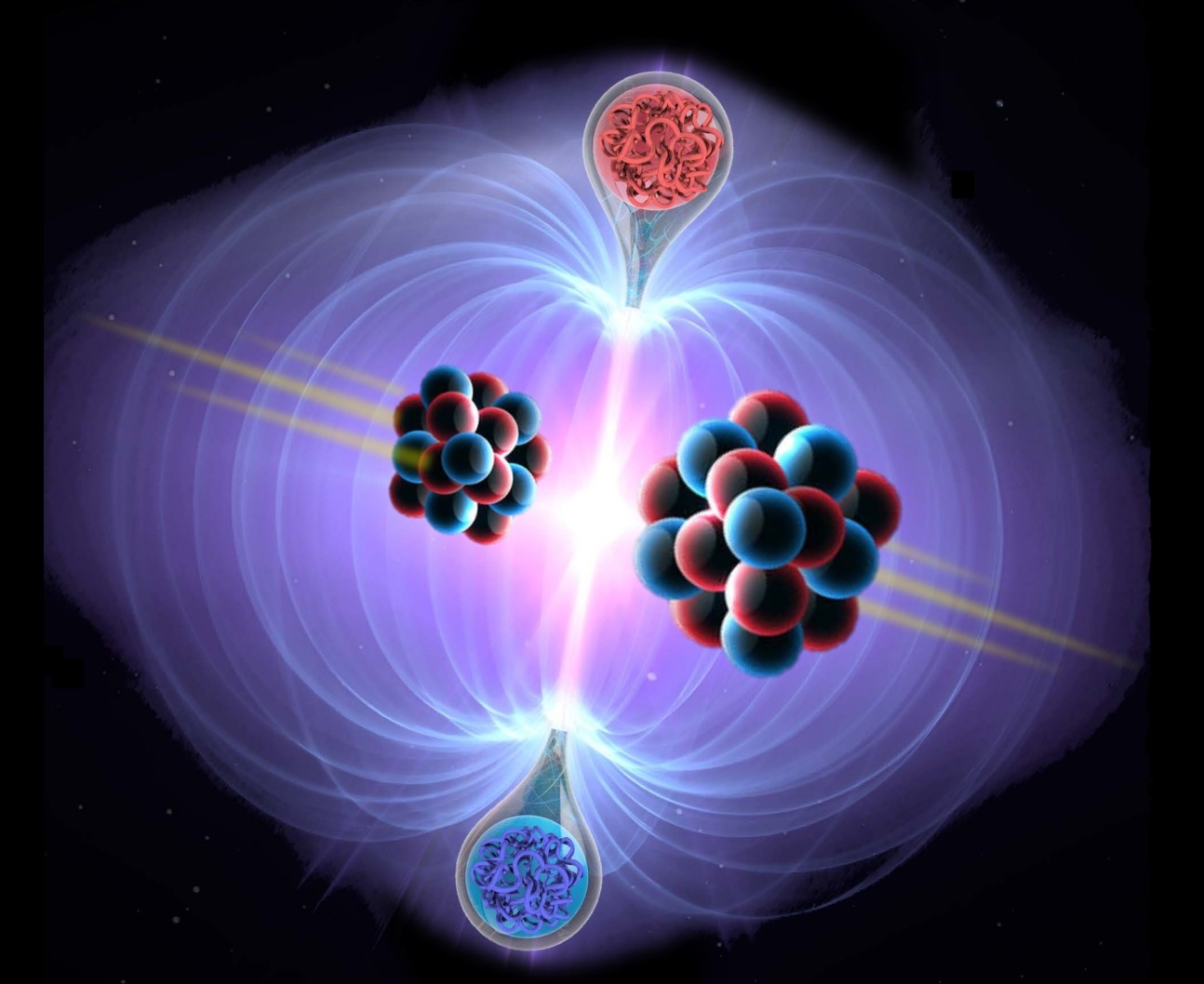
The creation of magnetic monopoles from heavy ion collision. Credit: James Pinfold, MoEDAL Collaboration

New experiments at the Large Hadron Collider are narrowing the search for magnetic monopoles – particles with only a North or South magnetic pole.
All known elementary particles have both a North and a South pole – like a traditional bar magnet – but scientists have good theoretical grounds to believe monopoles exist. If found, they could shed new light on electromagnetism and the unification of fundamental forces.
These new experiments ... have given us a much more solid idea of where the search for monopoles can go next. Professor Arttu Rajantie
Now, a new class of experiments at the Large Hadron Collider (LHC) at CERN, first envisaged by Imperial physicists, have created conditions more likely to produce monopoles. Although none have been found yet, the new experiments have allowed researchers to refine the likely properties of monopoles, directing the course of future experiments.
The results, produced by the MoEDAL (Monopole and Exotics Detector at the LHC) team which includes Imperial College London researchers, are published today in the journal Nature.
Co-author Professor Arttu Rajantie from the Department of Physics at Imperial, whose team developed the theory behind the new experiments, said: “Describing how magnetic monopoles would behave at high energies is a long-standing open problem in theoretical physics. As they would interact very strongly with the electromagnetic field, the same techniques we use for other particles do not work.
“Because of this, the conclusions physicists have been able to draw from previous experiments at the LHC and elsewhere have been limited. These new experiments however, using a different production mechanism, allow us to categorically rule out the existence of certain types of monopoles and have given us a much more solid idea of where the search for monopoles can go next.”
Colliding heavy ions
The LHC most commonly smashes together single protons at extremely high energies. Although the MoEDAL experiment analyses these collisions, there isn’t a good theoretical understanding of how monopoles might be produced in these events.
 In 2018, the LHC smashed together a different kind of particle – heavy ions, in the form of lead nuclei. These particles contain hundreds of protons and neutrons, and this heaviness means they can only collide at lower energies than single-proton collisions.
In 2018, the LHC smashed together a different kind of particle – heavy ions, in the form of lead nuclei. These particles contain hundreds of protons and neutrons, and this heaviness means they can only collide at lower energies than single-proton collisions.
However, if these lead nuclei clip each other or pass very close, the interaction can create something spectacular: the strongest magnetic fields known in the universe, a million times stronger than those found in neutron stars. These only last for an extremely short time, but their existence provides a different mechanism for producing magnetic monopoles.
The theory follows a mechanism for creating the electrical version of monopoles: electrons and their antimatter equivalent, positrons. The ‘Schwinger mechanism’, proposed in the 1930s, says that a strong electrical field will interact with quantum fluctuations in a vacuum and produce electrons and positrons. Similarly, a strong magnetic field should produce North and South monopoles.
How heavy is a monopole?
In contrast to proton-proton collisions where particles are produced by a single violent collision, in the Schwinger mechanism they arise from a large number of small interactions, which researchers can describe theoretically. Importantly, this allows researchers to predict how many monopoles would be produced by this mechanism.
However, the prediction does depend on how heavy monopoles are. If they are too heavy, the lead nuclei collisions at the LHC would not be energetic enough to produce them.
This was found to be the case in the 2018 run of experiments; no monopoles were produced. The experiments do, however, prove that if monopoles do exist, they are heavier than a certain limit (75 GeV/c2). This allows new predictions to be made for future experiments that smash lead nuclei together at higher energies.
The experiment also shows that colliding heavy ions like lead nuclei is a valid method to search for new particles. Professor Rajantie said: “Proton-proton collisions, being so high energy, are often thought of as the sole frontier for discovering new physics, with heavy-ion collisions useful only for examining known phenomena at lower energies.
“Our search for monopoles shows that these low-energy but strong-magnetic-field experiments can also be used to search for new physics. Upgrades to the LHC and future experiments – such as the proposed Future Circular Collider, slated to be nearly four times as long as the LHC’s 27km circumference – should bear this in mind.”
-
‘First experimental search for production of magnetic monopoles via the Schwinger mechanism’ by B. Acharya et al. is published in Nature.
Supporters

Article text (excluding photos or graphics) available under an Attribution-NonCommercial-ShareAlike Creative Commons license.
Photos and graphics subject to third party copyright used with permission or © Imperial College London.
Reporter
Hayley Dunning
Communications Division

Contact details
Tel: +44 (0)20 7594 2412
Email: h.dunning@imperial.ac.uk
Show all stories by this author
Leave a comment
Your comment may be published, displaying your name as you provide it, unless you request otherwise. Your contact details will never be published.




Comments
Comments are loading...